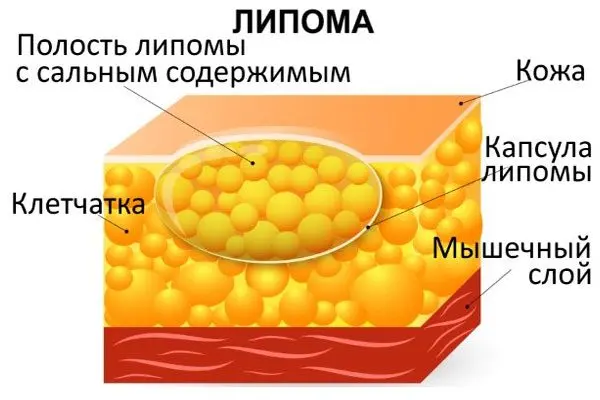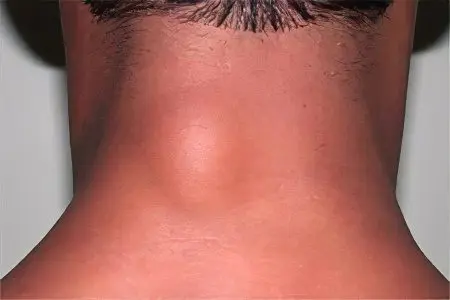Contents
Lipoma – what is it?

Lipoma is a benign neoplasm consisting of adipose tissue, which is most often localized under the skin, but can also be found in internal organs that have a fatty layer.
Lipoma can be diagnosed at any age, in people of any gender. Most often they are detected in women aged 30-50 years. Outwardly, it looks like a subcutaneous node, which has a soft structure, it is mobile and painless. The node is not soldered to the surrounding tissues. The average size of a lipoma is 2 cm, but sometimes giant neoplasms form in people.
Lipoma can be represented not only by adipose, but also by connective tissue. In this case, it has a denser consistency.
There are both single and multiple neoplasms. They can be located on the back, on the shoulders, on the chest, on the legs and on the stomach. In general, any place in the human body that is not deprived of adipose tissue can become the basis for the development of a lipoma. Often they are found on the scalp, covered with hair, on the face, behind the ears.
Lipomas do not become malignant, as they are in capsules. Like all other benign tumors, lipomas grow slowly, do not metastasize, do not grow into other tissues and organs. It is the capsule that makes the growth of the lipoma non-aggressive.
The main areas of the human body where lipomas can form:
Skin and subcutaneous fat (subcutaneous lipoma).
Fat deposits located between the muscles (myolipoma).
The fatty membrane that surrounds the kidneys (angiolipoma).
Milk glands.
Retroperitoneal fat.
Rib cage.
Intestines.
Rare places of lipoma localization: heart muscle, brain, lungs, nerve trunks (perineural lipoma), bones, sweat glands.
Lipomas can be topical and heterotopic. Topical lipomas consist of those fat cells that are present in the organ on which they form. Heterotopic lipomas are diagnosed very rarely, they can form on the uterus, liver and in the cranial cavity. Since there are no fat cells in these organs, lipomas are represented by fat, which, during fetal development, got there by accident.
Lipomas form in both thin and overweight people. Body weight in this case does not matter. If a person begins to lose weight, this does not affect the neoplasm in any way. The lipoma will continue its slow growth.
Types of lipoma

Depending on the histological structure, two types of lipomas are distinguished:
Knotty. Lipoma is represented by a node enclosed in a capsule. The tumor itself consists of lobules of different sizes. The lobules are represented by fat cells. Most lipomas have a nodular structure.
Diffuse. These lipomas are rare. They are composed of fat cells and characterize a disease called lipomatosis (systemic damage to adipose tissue).
Depending on whether there are cells other than fat in the lipoma, there are:
Classical lipoma – consists only of fat cells.
Fibrolipoma – the tumor is represented by fat cells and connective tissue.
Myolipoma – a tumor composed of fat cells and muscle tissue.
Myxolipoma – this neoplasm contains fat cells and mucus.
Angiolipoma, in this tumor, in addition to fat cells, there are blood vessels.
Myelolipoma, in such lipomas, in addition to fat cells, there are particles of bone marrow.
Hibernoma is a tumor represented by brown fat cells.
Depending on the structural features of the tumor, the following types of lipomas are distinguished:
The cervical annular tumor is represented by multiple lipomas and looks like a kind of necklace located on the neck.
Encapsulated lipoma, which forms in a capsule surrounding an organ.
Tree-like lipoma, which has growths that resemble the crown of a tree in appearance. Such lipomas form in the joint cavities.
Cavernous lipoma, which is riddled with many vessels.
Lipoma on the leg. The leg is represented by a flap of skin or connective tissue of the organ on which the tumor is located.
A soft lipoma that, in addition to fat cells, contains fluid, such as mucus.
Dense lipoma, which contains connective tissue.
Reasons for the formation of a lipoma

Experts have identified two mechanisms for the formation of lipomas:
The lipoma grows like a tumor. At the same time, neoplasm fat cells multiply from one cell, being its clones. Therefore, most lipomas have a lobed structure.
Lipoma is formed against the background of a violation of the outflow of the sebaceous glands. In this case, fat cells begin to accumulate in the lumen of the gland. Such lipomas most often come to the surface through the lumen of the sebaceous gland and do not have lobules.
As for the reasons that lead to the formation of lipomas, there are several of them:
Hereditary predisposition. In this case, we are talking about a disease such as lipomatosis, which is characterized by the formation of many tumors. This pathology is inherited in an autosomal dominant manner and manifests itself in youth, regardless of the sex of the child.
Fat metabolism disorders. Violations of fat metabolism, which lead to the formation of lipomas, do not depend on what kind of physique the person himself is. It can be both thin and full. In this case, an increase in low-density lipoproteins in the blood occurs. Such fats cannot freely pass through the walls of blood vessels and clog them. If this process progresses, the person develops a disease called atherosclerosis. At the same time, atherosclerotic plaques form on the vessels, and the liver suffers from fatty hepatosis. In narrow capillaries, fat deposits become so intense that it leads to blockage of their lumen. Gradually, fatty deposits in these places begin to grow, a capsule is formed around them, which has multiple partitions, thus forming lipomas.
Risk factors leading to an increase in low-density lipoproteins in the blood: physical inactivity, the predominance of animal fats in the menu, genetic diseases. It should be noted that doctors call lipomas almost the only visible markers that can lead a person to think about high cholesterol levels in the blood and consult a doctor.
Failure in the regulation of fat metabolism. A coordinated mechanism is responsible for the distribution of fat in the body. It removes excess fat from food, regulates the accumulation of fat in different places depending on the gender of a person, etc. In general, this mechanism is automatically regulated by the body and does not require hormonal or any other control.
However, sometimes it happens that this most useful mechanism fails, and it does not concern the whole organism as a whole, but only specific sections of tissues. In this case, a person develops either neurogenic obesity, or lipomas form. Stress, sudden hypothermia, frostbite, exposure to radiation, trauma, etc. can provoke such a failure.
Errors in observing the rules of personal hygiene. Lipomas can form at the site of boils and pimples that have been opened incorrectly. In this case, pus remains inside, which leads to the formation of a focus of chronic inflammation. The sebaceous glands continue to secrete a thick secret that can block their lumen. The accumulated sebaceous secret forms a lipoma. It is covered with a capsule, but there will be no lobules in it.
It should be noted that all of the above reasons for the formation of lipomas are theories. Scientists still do not know for certain what exactly leads to their growth and development.
As diseases that increase the likelihood of a tumor, there are:
Diseases of the pancreas.
Diseases of the liver.
Alcohol abuse.
Hypothyroidism.
Diabetes.
The presence of malignant tumors in the upper respiratory tract.
Insufficiency of the function of the pituitary gland.
Lipoma symptoms

Lipoma most often does not make itself felt by any specific manifestations. The tumor does not hurt, does not cause a person to feel discomfort, etc. Therefore, if it is on the internal organs, the patient will not even have a suspicion that he has formed a neoplasm. Naturally, until the lipoma that has grown to an impressive size begins to put pressure on tissues and nerves. Depending on where exactly the tumor has formed, its symptoms will differ.
Symptoms of breast lipoma
Lipomas located in the tissues of the mammary gland have a smooth surface, and lobules are felt in its capsule. The closer the lipoma is to the surface of the skin, the more it will protrude. The skin of the chest will not have any changes.
If the lipoma is small and located deep in the breast tissue, then it can only be detected by chance, during a mammogram.
Lipomas of the mammary gland do not hurt and do not cause any physiological discomfort to the woman.
Skin lipoma symptoms
Lipoma, located under the skin, is represented by a rounded neoplasm that rises above the surface of the body. It has clear boundaries, regardless of its location.
If you touch the lipoma, you can find that it is mobile, not soldered to the tissues. Lipoma does not respond with pain. After you release the tumor shifted to the side, it will return to its place.
The surface of the skin, under which the lipoma is located, does not have any pathological changes, it is smooth and even, of a normal color.
Tumors tend to grow, but they increase in size very slowly. To notice that the lipoma has become larger, a person may need 5, and sometimes 10 years. In this case, the size of the neoplasm may not exceed 5 mm, but the formation of a large lipoma of 50 mm or even more is not excluded.
If the tumor is large, then it is able to greatly stretch the skin, hanging on the body like a bag. The sagging skin will serve as the leg. Such lipomas receive less nutrition, so they can become covered with ulcers and undergo necrosis.
Those lipomas on the skin that are located in places of constant friction with clothes or other parts of the body are capable of causing inconvenience. Such tumors will be injured all the time, inflamed. It is possible to attach suppuration, which requires specific treatment.
Large subcutaneous lipomas can put pressure on blood vessels and nerves, in nearby muscles and other tissues. This, in turn, disrupts their nutrition, causes pallor of the skin, promotes the formation of ulcers, slows down cell regeneration after injury, etc.
Symptoms of cervical lipoma
Lipoma of the neck has all the symptoms of subcutaneous lipoma on the trunk: it is soft, painless, mobile. However, it differs from other lipomas in that it is able to compress the larynx and airways, causing difficulties during breathing and swallowing food. Therefore, doctors strongly recommend removing such neoplasms.
Lipomatosis of the neck is a disease in which tumors form on the neck, folding into a “necklace”. This disease belongs to genetic pathologies and is inherited.
Symptoms of a lipoma on the kidney
Lipomas on the kidney are formed from the fatty capsule of the organ. Such neoplasms are most often small in size and do not manifest themselves in any way. However, as the tumor grows, the following symptoms may be added:
Persistent increase in blood pressure.
The appearance of pulling pains in the lower back.
The appearance of blood in the urine.
The occurrence of renal colic.
Varicocele.
When a renal lipoma grows up to 5 cm in circumference, a person will be able to palpate it independently.
Symptoms of a brain lipoma
If the lipoma of the brain is congenital, then it does not manifest itself in any way. Such tumors do not increase in size, therefore, do not require removal.
When a brain lipoma develops during life, that is, it is acquired, pathological symptoms may occur. They will begin to appear after the lipoma reaches a large size and begins to put pressure on the internal structures of the brain.
This will manifest itself with the following symptoms:
Chronic headaches.
Nausea.
Vomiting.
These symptoms are caused by increased intracranial pressure. It should be noted that acquired brain lipomas are diagnosed extremely rarely. Among the group of patients in whom such a tumor still develops, women aged 30-50 years predominate.
Symptoms of a peritoneal lipoma
The abdominal lipoma is formed in the fatty layer, which is between the sheet of the peritoneum and its muscles. The tumor begins to put pressure on the organs when it reaches a size of 5-7 cm.
Symptoms of peritoneal lipoma directly depend on which organ is subjected to pressure. So, if it is the stomach, then the person will experience heartburn attacks, nausea, belching and other digestive disorders.
Symptoms of lung lipoma
Until that moment in time, until the lipoma reaches the pleura, the person will not know about its existence. After this happens, a symptom such as a cough will come to the fore. It appears due to the fact that the tumor irritates the pleura. This process will also be accompanied by pain.
Symptoms of heart lipoma
Lipoma of the heart is manifested by various disorders in the work of the organ, so the patient is diagnosed with arrhythmia. As the tumor grows, the contractility of the heart muscle will decrease, leading to the development of heart failure and pulmonary edema.
Lipoma diagnostics

If a person suspects that he has formed a lipoma, then he needs to contact an oncologist. When there is no opportunity to directly get to this specialist, then for a start you can visit a therapist and a surgeon.
As a rule, the diagnosis of lipoma does not cause difficulties for the doctor. This tumor does not hurt, slowly increases in size. An additional indirect sign indicating that the patient has a lipoma, and not another tumor, may be an elevated blood level of cholesterol and triacylglycerols, as well as LDL. Although sometimes lipomas can form even against the background of normal blood cholesterol levels.
To clarify the structure of the tumor, the patient is prescribed an ultrasound. During the study, the doctor determines the exact location of the lipoma, its size, connection with surrounding tissues and organs.
Lipomas of internal organs require CT or MRI. Vascular contrasting provides information on how much the tumor is penetrated by blood vessels.
Morphological examination of the tumor is carried out after its removal. Since the lipoma is a benign formation, the patient does not receive further treatment. He is recovering from the operation and returning to his normal life.
If during the histological examination it turns out that the tumor was malignant, then the patient will have to undergo a course of radiation therapy and chemotherapy. However, such a neoplasm is no longer called a lipoma.
It is also possible to biopsy the lipoma until it is removed. With the help of this analysis, the doctor is convinced that he has a benign tumor in front of him, which does not always require removal.
What is the difference between lipoma and atheroma?
Atheroma is a benign neoplasm that is formed as a result of blockage of the sebaceous glands. Atheromas can form only in the upper layers of the skin and always communicate with the external environment.
Atheromas, unlike lipomas, do not reach large sizes, have a dense structure, and are always connected to the skin.
If lipomas are represented by fatty lobules, then atheromas consist of sebum and particles of the epidermis.
Atheromas are able to fester, since dirt, bacteria, dust particles can get into the duct, through which they communicate with the external environment.
Many people call lipomas and atheromas wen, although only a lipoma is a wen, and atheroma is more like a boil in structure.
Criterion | Lipoma | Atheroma |
Is the tumor inflamed | Extremely rare, when rubbing with clothes or other parts of the body | Often inflamed and purulent |
Is there a communication with the external environment | No | Yes, in a flow |
Structure | Soft, dense, has lobules | Firm and elastic |
The need for removal | Observation possible | Requires removal |
Mobility relative to the skin | Movable | Not mobile, soldered to the inner surface of the skin |
growth rate | Slow growth | Fast growth |
Possibility of growth on internal organs | Yes | No |
Is lipoma dangerous?

Although the lipoma does not pose a danger in terms of malignancy, nevertheless, it can reduce the patient’s quality of life. So, a growing tumor does not germinate, but pushes the tissues apart, which leads to compression of the vessels, disrupts the metabolic processes in them. Medicine knows cases when lipomas reached 2 kg of weight and required immediate removal due to exerting strong pressure on nearby soft tissues.
Large lipomas are also dangerous because their capsules can rupture. If this happens, then the contents of the tumor enter the soft tissues. This process can provoke the development of serious complications. Rarely, but still, it happens that the fat contained in the lipoma enters the systemic circulation and leads to embolism.
When lipomas are located around the circumference of the neck, they can lead to respiratory and swallowing disorders (if they reach a large size). Sometimes people suffer from asthma attacks, face speech disorders. With large lipomas, the risk of swelling of the tissues of the neck increases. In the future, angina attacks may occur.
A lipoma formed on the neck or armpit can cause pain, as it is subjected to constant pressure. In those places where the lipoma is in contact with clothing, it can macerate, bleed, become inflamed, ulcerate.
A lipoma formed on the face or on the body is a cosmetic defect, due to which many people cannot wear the clothes they like, which causes psychological discomfort.
Lipoma treatment
Treatment of a lipoma is reduced to its surgical removal. It does not dissolve on its own under any circumstances. However, surgery upon detection of a lipoma is not a prerequisite for its treatment.
Should a lipoma be removed?
As mentioned, lipoma does not always need to be removed.
There are several absolute indications for surgery:
The presence of an intracranial lipoma, which puts pressure on the internal structures of the brain.
The presence of a threat of rupture of the lipoma into the abdominal cavity or retroperitoneal space.
Lipoma interferes with the flow of cerebrospinal fluid.
Lipoma provokes disturbances in the work of the heart.
The patient should seriously consider removing the lipoma in the following cases (relative indications):
Lipoma puts pressure on the nerves and provokes constant pain.
Lipoma formed on the liver or kidneys.
Lipoma is constantly exposed to injury.
Lipoma disrupts the normal blood supply to an organ.
The lipoma is growing rapidly.
The lipoma is large.
Lipoma is located on the leg.
If these indications for the operation are absent, then it is up to the patient to remove the lipoma or not.
Next, consider the main types of lipoma removal.
Liposuction
The procedure for removing a lipoma during liposuction is carried out using a special device called a lipoaspirator. This operation allows you to get rid of the lipoma without leaving visible scars or scars on the skin. An incision is made in an inconspicuous place, into which the doctor inserts a lipoaspirator (a thin tube that creates a vacuum and sucks the entire contents of the capsule into itself). The vacuum works like a vacuum cleaner. When the tumor is completely removed, the doctor removes the device and sews up a small scar, or simply puts a patch on the injury site.
Liposuction is performed with lipomas that are not located in cavities, for example, with lipomas of muscles, tendons, mammary glands, etc. The undoubted advantages of the procedure are: high speed of the operation, no scarring after the intervention, and a quick rehabilitation period.
As for the shortcomings, it is one – a lipoma can form again, because it is impossible to remove its capsule during the operation.
Surgical excision of a lipoma
Surgical excision of a lipoma is a radical method to remove the tumor, which ensures that it does not recur. During the procedure, the doctor makes an incision with a scalpel, exposes the capsule of the lipoma and excised it together with the shell with scissors. When the neoplasm is removed, a suture is applied to the incision site.
This method has one advantage – it guarantees the absence of recurrence of the lipoma. However, its disadvantage is high trauma. Therefore, surgical excision of a lipoma is prescribed only when the tumor has an impressive size, or is located in hard-to-reach places, which affects the functioning of organs or tissues.
Endoscopic removal of a lipoma
In this case, the lipoma is removed using a special device called an endoscope. The doctor makes several incisions on the patient’s skin, through which he inserts special tubes. They are equipped with a camera and a scalpel. The image of the internal organs and lipoma is displayed on the screen. The doctor removes the lipoma with the help of manipulators, after which he removes the device and sutures the place of damage.
Endoscopic removal of a lipoma is the best option for getting rid of a tumor located on the internal organs. At the same time, the method allows you to get rid of the neoplasm along with the capsule, which guarantees the absence of relapses. In addition, the operation is not associated with pronounced cosmetic defects, since small punctures on the skin become completely invisible over time.
Not all hospitals are equipped with endoscopic equipment, so operations remain inaccessible for a number of people. In addition, endoscopic intervention requires the introduction of general anesthesia.
Laser removal of lipoma
Removing a lipoma with a laser is a bloodless, safe and less traumatic method of getting rid of the tumor. However, it can be used only if the neoplasm is localized in the subcutaneous adipose tissue. This is practically the only drawback of the method.
During the procedure, the doctor dissects the tissues with a laser beam, exposes the lipoma capsule, fixes it with forceps and removes it from the tissues. The edges of the incision are tightened with adhesive tape.
Radio wave removal of lipoma
The radio wave method of removing a lipoma is used only if the tumor diameter does not exceed 6 cm. The tissues are cut with a radio wave knife (a tungsten filament under tension). The doctor, step by step, separates the lipoma from the tissues and removes it. The wound is fixed with a suture or with an adhesive plaster. The method is good in that it is less traumatic and does not create a cosmetic defect. In addition, during the procedure, the blood vessels are immediately coagulated, which eliminates the risk of bleeding. However, radio wave removal of a lipoma is limited by the size of the tumor and its location.
Are there any remedies for lipoma?
Thuja (white cedar tree) – according to a 2013 study, thuja helped cure malignant warts caused by HPV. Proponents of natural treatment believe that it can also be effective for lipoma.
Boswellia serrata (Indian frankincense) – a review of clinical studies in 2013 showed a good anti-inflammatory effect of Boswellia. Natural healing practitioners suggest that Indian frankincense may also be effective for lipoma.
However, you must understand that there are no studies that would confirm the effectiveness of these drugs for lipoma. No other folk remedies can help you. Do not listen to the recommendations on the use of various lotions and ointments, they can only help with ordinary wen, but not with lipoma.
Can a lipoma resolve itself?
By itself, the lipoma cannot resolve itself, since it is surrounded by a dense capsule. If a person had a wen, which eventually passed on its own, then it was not a lipoma, but a different neoplasm. True lipomas do not resolve.









